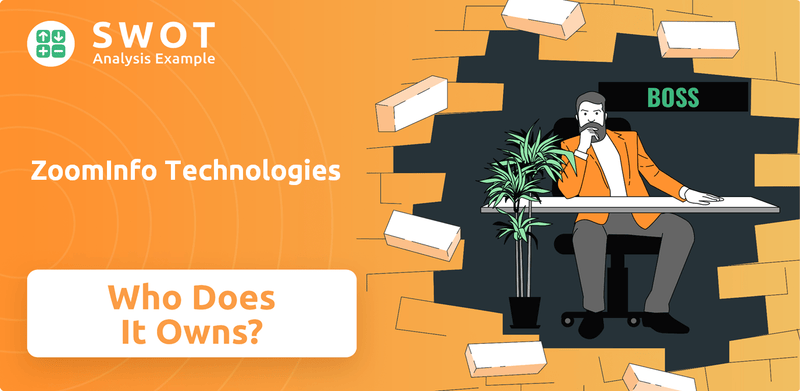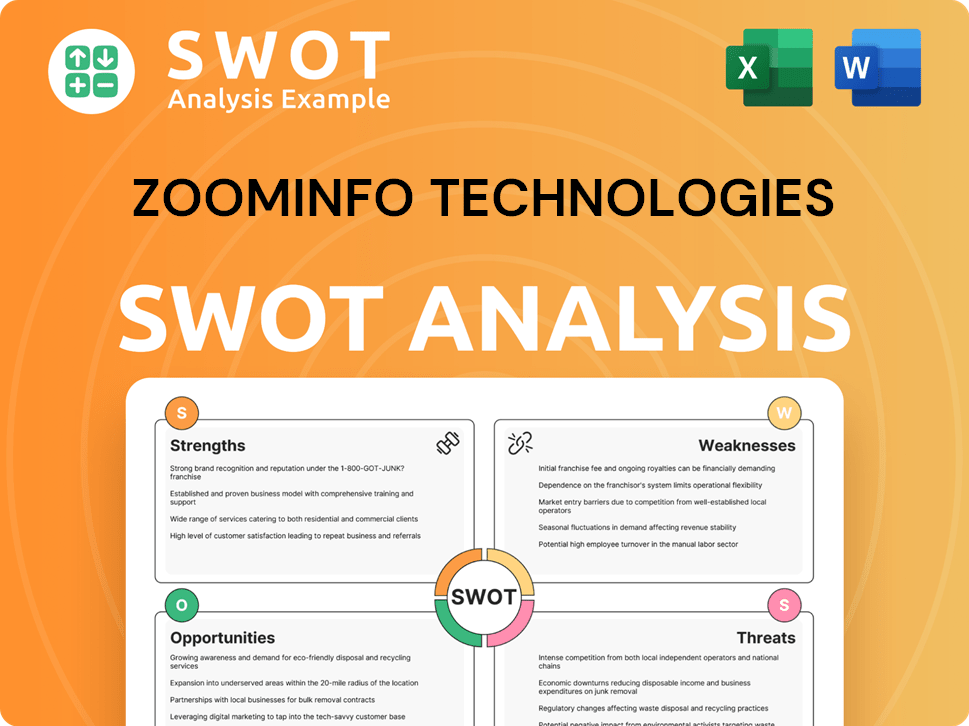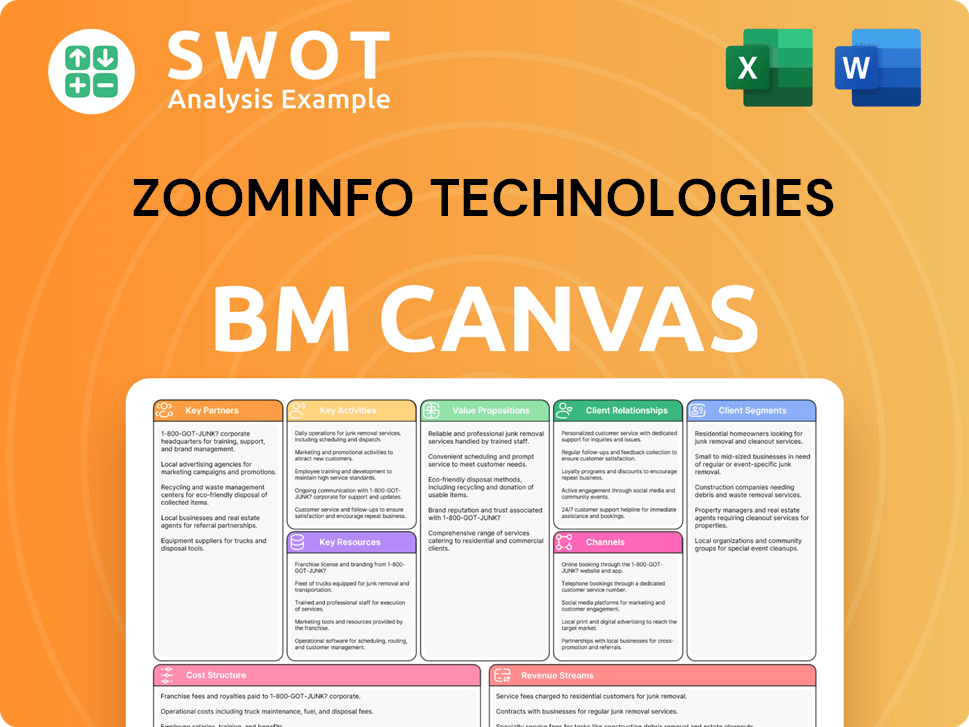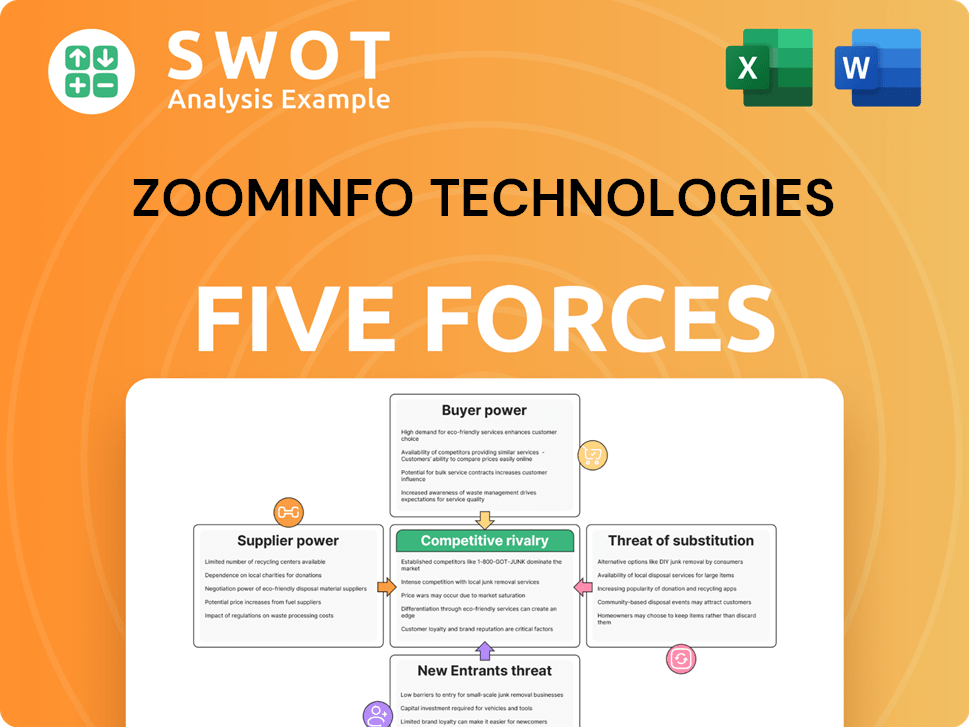ZoomInfo Technologies Bundle
Who Really Owns ZoomInfo Technologies?
Understanding a company's ownership structure is crucial for investors and business strategists alike. ZoomInfo Technologies, a leading SaaS provider, has undergone a significant transformation since its inception. This evolution, particularly after its IPO in June 2020, has reshaped its ownership landscape and strategic direction.

Founded in 2007 by Henry Schuck and Kirk Brown as DiscoverOrg, ZoomInfo Technologies SWOT Analysis reveals the company's growth into a major player in the B2B intelligence market. Its platform offers valuable data for sales and marketing teams, making it essential to understand the current ZoomInfo ownership and how it impacts the company's future. Exploring the ZoomInfo company's ownership details, including ZoomInfo investors and stakeholders, provides critical insights into its operations and potential.
Who Founded ZoomInfo Technologies?
The story of ZoomInfo Technologies Inc. starts with two separate entities, eventually merging into the company we know today. The journey began with DiscoverOrg, founded in 2007 by Henry Schuck and Kirk Brown. Later, it evolved through strategic acquisitions to become the current ZoomInfo.
Before the merger, Zoom Information Inc. was established in 2000 by Yonatan Stern and Michel Decary. This earlier version of the company played a crucial role in the evolution of ZoomInfo. The acquisition of this original entity by DiscoverOrg marked a pivotal moment.
The co-founders of DiscoverOrg, Henry Schuck and Kirk Brown, launched their business with an initial investment of $25,000 each, using personal credit cards. After the IPO, Henry Schuck held a 10% stake, and Kirk Brown owned 7.3% of the company.
DiscoverOrg was founded in 2007 by Henry Schuck and Kirk Brown.
Each founder initially invested $25,000.
Zoom Information Inc. was founded in 2000 by Yonatan Stern and Michel Decary.
DiscoverOrg acquired Zoom Information Inc. in February 2019.
Henry Schuck, Cameron Hyzer, and Chris Hays retained their leadership roles after the acquisition.
Post-IPO, Henry Schuck owned 10%, and Kirk Brown owned 7.3%.
Understanding the ZoomInfo ownership structure involves tracing the company's evolution through acquisitions and the roles of its founders.
- DiscoverOrg's founders, Henry Schuck and Kirk Brown, played a critical role in shaping the company.
- The acquisition of Zoom Information Inc. by DiscoverOrg was a key event.
- Post-IPO, the founders held significant ownership stakes.
- The company's history includes venture capital funding and private equity involvement.
ZoomInfo Technologies SWOT Analysis
- Complete SWOT Breakdown
- Fully Customizable
- Editable in Excel & Word
- Professional Formatting
- Investor-Ready Format

How Has ZoomInfo Technologies’s Ownership Changed Over Time?
The evolution of ZoomInfo Technologies company history has been significantly shaped by its transition from a private to a public entity. The initial public offering (IPO) on June 4, 2020, marked a pivotal moment, raising approximately $1 billion and establishing a market capitalization of $8.3 billion. This event altered the ownership landscape, introducing a mix of institutional, insider, and individual investors.
Prior to the IPO, private equity firms Carlyle Group and TA Associates held a substantial combined stake of about 60%. The IPO reshaped this, with TA Associates holding 36% and Carlyle Group holding 31% post-IPO. The current ownership structure reflects a diverse group of investors, with institutional investors holding the majority of shares.
| Key Event | Date | Impact on Ownership |
|---|---|---|
| IPO | June 4, 2020 | Transitioned from private to public; introduced institutional and individual investors. |
| Private Equity Ownership | Pre-IPO | Carlyle Group and TA Associates held a significant combined stake. |
| Post-IPO Ownership | Ongoing | Institutional investors became the majority shareholders, with continued insider ownership. |
As of May 2025, the ownership structure of ZoomInfo (NasdaqGS:ZI) is predominantly held by institutional investors, accounting for approximately 79.44% of the company's stock. Key institutional shareholders include Vanguard Group Inc. and BlackRock, Inc. Insiders, such as CEO Henry Schuck, hold a notable percentage, while public companies and individual investors make up the remainder. Carlyle Group Inc. remains a significant insider shareholder. This distribution reflects the company's shift from private equity control to a more diversified public ownership model.
ZoomInfo's ownership structure is a blend of institutional investors, insiders, and individual investors. The IPO in 2020 was a major turning point, changing the ownership dynamics. Institutional investors hold the largest share, with significant stakes held by Vanguard and BlackRock.
- Institutional investors own a significant portion of the company.
- Insiders, including the CEO, also hold substantial shares.
- Private equity firms had a major role before the IPO.
- The ownership structure has evolved since the company went public.
ZoomInfo Technologies PESTLE Analysis
- Covers All 6 PESTLE Categories
- No Research Needed – Save Hours of Work
- Built by Experts, Trusted by Consultants
- Instant Download, Ready to Use
- 100% Editable, Fully Customizable

Who Sits on ZoomInfo Technologies’s Board?
The board of directors at ZoomInfo Technologies Inc. guides the company's strategic direction and ensures proper governance. A significant figure on the board is Henry Schuck, the CEO and co-founder. As a 'controlled company' under Nasdaq guidelines, the board's composition and decision-making processes are shaped by the company's ownership structure and the influence of major shareholders.
The ownership structure of ZoomInfo, particularly the voting power distribution, is crucial for understanding the company's governance. The company's structure grants significant control to certain shareholders. This includes the founders and private equity firms, which hold a substantial portion of the voting rights through super-voting shares.
| Board Member | Title | Affiliation |
|---|---|---|
| Henry Schuck | CEO & Director | ZoomInfo |
| Bryan Law | Director | TA Associates |
| David Hummer | Director | Carlyle |
| Michael Callahan | Director | ZoomInfo |
ZoomInfo's multi-class stock structure is a key aspect of its ownership and control dynamics. Holders of Class A common stock have one vote per share, while Class B and Class C shareholders have ten votes per share, provided the aggregate of these shares represents at least 5% of the total outstanding common stock. This arrangement concentrates voting power, particularly with founders and private equity firms, influencing corporate decisions significantly. This impacts the company's strategic direction and responsiveness to shareholder concerns. For more insights, explore the Growth Strategy of ZoomInfo Technologies.
ZoomInfo's ownership structure grants significant control to specific shareholders. This includes the founders and private equity firms, who hold a substantial portion of the voting rights through super-voting shares.
- The multi-class stock structure concentrates voting power.
- Class A shares have one vote, while Class B and C have ten.
- The board is classified, making changes more challenging.
- Class action lawsuits indicate scrutiny over disclosures.
ZoomInfo Technologies Business Model Canvas
- Complete 9-Block Business Model Canvas
- Effortlessly Communicate Your Business Strategy
- Investor-Ready BMC Format
- 100% Editable and Customizable
- Clear and Structured Layout

What Recent Changes Have Shaped ZoomInfo Technologies’s Ownership Landscape?
Over the past few years, ZoomInfo Technologies has actively managed its capital structure, including significant share repurchase programs. In 2024, the company repurchased 46.8 million shares, which is about 12% of total shares outstanding. The average price per share was $12.01, totaling $562.3 million. The Board of Directors approved an additional $500 million share repurchase authorization in February 2025. In the first quarter of 2025, ZoomInfo repurchased 8.6 million shares for $95.0 million, with an average price of $11.05.
ZoomInfo has also been involved in strategic acquisitions. On January 13, 2025, the company completed a merger/acquisition with Workbounce. Furthermore, the company announced a ticker symbol change from 'ZI' to 'GTM' effective May 13, 2025. These actions demonstrate ZoomInfo's ongoing efforts to optimize its financial structure and expand its business operations.
| Metric | Value | Year |
|---|---|---|
| Institutional Ownership | 79.44% | March 2025 |
| Dragoneer Investment Group, LLC, Reduction in Stake | 71.41% | February 2025 |
| FMR LLC Reduction in Holdings | 48.75% | February 2025 |
Institutional ownership remains a significant factor in the ZoomInfo ownership structure. As of March 2025, institutional ownership stood at 79.44%. However, there have been some shifts in holdings by certain institutional investors. For example, Dragoneer Investment Group, LLC, reduced its stake by 71.41% to 6,323,331 shares as of February 2025, and FMR LLC reduced its holdings by 48.75% to 16,938,251 shares in February 2025. These changes reflect the dynamic nature of the ZoomInfo investors landscape and the ongoing adjustments within the company's shareholder base. To understand more about their business model, you can read about the Revenue Streams & Business Model of ZoomInfo Technologies.
ZoomInfo's ownership structure is primarily influenced by institutional investors. Recent share repurchase programs and acquisitions reflect strategic financial management. The company's revenue for 2024 was $1,214.3 million, a 2% decrease compared to 2023.
Institutional ownership remains high but has seen some reductions from key investors. Dragoneer Investment Group, LLC, and FMR LLC have decreased their stakes. The company anticipates a slight revenue decrease in 2025, focusing on customer acquisition.
ZoomInfo reported full-year 2024 revenue of $1,214.3 million. For 2025, GAAP revenue is projected between $1.195 billion and $1.205 billion. The company is investing in sales and marketing to grow.
Major shareholders include institutional investors, with significant holdings. The company's ownership is dynamic, with ongoing adjustments by institutional investors. Understanding the ownership structure is crucial for investors.
ZoomInfo Technologies Porter's Five Forces Analysis
- Covers All 5 Competitive Forces in Detail
- Structured for Consultants, Students, and Founders
- 100% Editable in Microsoft Word & Excel
- Instant Digital Download – Use Immediately
- Compatible with Mac & PC – Fully Unlocked

Related Blogs
- What are Mission Vision & Core Values of ZoomInfo Technologies Company?
- What is Competitive Landscape of ZoomInfo Technologies Company?
- What is Growth Strategy and Future Prospects of ZoomInfo Technologies Company?
- How Does ZoomInfo Technologies Company Work?
- What is Sales and Marketing Strategy of ZoomInfo Technologies Company?
- What is Brief History of ZoomInfo Technologies Company?
- What is Customer Demographics and Target Market of ZoomInfo Technologies Company?
Disclaimer
All information, articles, and product details provided on this website are for general informational and educational purposes only. We do not claim any ownership over, nor do we intend to infringe upon, any trademarks, copyrights, logos, brand names, or other intellectual property mentioned or depicted on this site. Such intellectual property remains the property of its respective owners, and any references here are made solely for identification or informational purposes, without implying any affiliation, endorsement, or partnership.
We make no representations or warranties, express or implied, regarding the accuracy, completeness, or suitability of any content or products presented. Nothing on this website should be construed as legal, tax, investment, financial, medical, or other professional advice. In addition, no part of this site—including articles or product references—constitutes a solicitation, recommendation, endorsement, advertisement, or offer to buy or sell any securities, franchises, or other financial instruments, particularly in jurisdictions where such activity would be unlawful.
All content is of a general nature and may not address the specific circumstances of any individual or entity. It is not a substitute for professional advice or services. Any actions you take based on the information provided here are strictly at your own risk. You accept full responsibility for any decisions or outcomes arising from your use of this website and agree to release us from any liability in connection with your use of, or reliance upon, the content or products found herein.